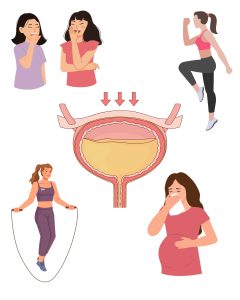10
Urinary Dysfunction
Urinary dysfunction can significantly disrupt daily life in various ways. Those experiencing urinary incontinence often see their self-esteem suffer, impacting professional and social interactions. The anxiety over potential leakage can lead to unexpected expenses on disposable products like pads and liners.
Fear of leaking during physical activities often discourages exercise, as individuals avoid movements that might trigger incontinence. Wardrobe choices are influenced too, with many steering clear of white clothing or fitted garments to prevent embarrassing situations.
Daily routines transform as individuals constantly scout for restrooms, which limits their enjoyment of outings. Social gatherings become sources of anxiety, as the fear of accidents overshadows the joy of shared experiences. This mental burden can lead to feelings of confinement at home, preventing complete relaxation due to ongoing restroom anxiety. Overall, managing urinary dysfunction presents significant challenges to personal well-being and social interactions.
| Stress Incontinence | heightened abdominal pressure during stress and compromised pelvic floor strength |
| Urge Incontinence | involuntary tightening of the bladder muscles |
| Overflow Incontinence | obstruction of the urethra |
| Neurogenic Incontinence | disrupted functioning of the nervous system |
Stress Incontinence:
May happen with:

- coughing
- exercising
- laughing
- lifting
- jumping
- shouting
Urge Incontinence:
May happen when:
- hearing/seeing water running
- the minute you put the key in the door
Poor voiding habits
“Just In Case” (JIC) urination – This is a behavior where individuals feel compelled to use the restroom before leaving someplace even when they don’t have a pressing need to go. For example, going to the bathroom before leaving for work. This often leads to a heightened sense of urgency when it comes to urination, prompting some to strain or rush their flow to avoid any potential discomfort later. This also decreases their bladder’s capacity as it trains to empty when it is not full.
Hovering – Public restrooms can significantly increase anxiety for many individuals, particularly due to worries about hygiene and cleanliness. This fear often leads people to opt for hovering over toilet seats instead of sitting directly on them. The avoidance of direct contact is driven by concerns about the presence of germs and the overall sanitation of the facility. However, it’s crucial to recognize that hovering can pose risks to health, specifically by putting strain on the pelvic floor muscles. Prolonged hovering may lead to issues such as pelvic pain or dysfunction. Therefore, while the instinct to avoid direct contact is understandable, it may be more beneficial to take precautions such as using disposable seat covers or sanitizing wipes to create a more comfortable and safe experience.
Fluid restriction – Additionally, some individuals consciously restrict their water intake throughout the day in an effort to minimize bathroom visits, which can result in dehydration. This can be particularly problematic, as staying hydrated is essential for overall health. Dehydration irritates the bladder and increases the feeling to urinate more often, especially when there is bladder inflammation or kidney problems.
Ignoring body signals – The pressure of a busy schedule may lead them to ignore their bodily signals, choosing to hold their bladder for extended periods due to an absence of breaks at work, which perpetuates a cycle of discomfort and urgency.
Poor voiding symptoms:
| Dysuria | Hesitancy | Incomplete | Immediate re-void | Intermittency |
| Post-void dribble | Slow stream | Spraying | Straining | Retention |
Potential bladder irritants:
- Alcohol

- Artificial sweeteners
- Carbonated beverages
- Caffeine
- Chocolate
- Citrus fruits
- Coffee/tea
- Dairy products
- Spicy foods
- Tomatoes
Bowel Conditions
Common gastrointestinal conditions affecting women can significantly impact quality of life. One prevalent issue is heartburn and gastroesophageal reflux disease (GERD), caused by stomach acid flowing back into the esophagus. Managing these symptoms involves:
- limiting caffeine
- consuming smaller meals
- avoiding carbonated and spicy foods
- maintaining a healthy weight
- wait to lie down after eating
Another condition, gastroparesis, features delayed gastric emptying, resulting in bloating and nausea. Relief can be found with smaller, low-fat meals, as high-fat foods can worsen the situation. Medications may help but require careful consideration.
Gastritis, inflammation of the stomach lining, can lead to symptoms like stomach pain and indigestion, necessitating lifestyle changes to reduce irritation.
Constipation is common, especially in older women and post-partum, and is manageable with a fiber-rich diet, adequate hydration, and regular exercise.
Irritable Bowel Syndrome (IBS) is more prevalent in women, with symptoms like abdominal pain and altered bowel habits. Triggers can include diet and stress.
Lastly, Inflammatory Bowel Disease (IBD), encompassing Crohn’s disease and Ulcerative Colitis, involves chronic gastrointestinal inflammation and can lead to severe symptoms such as diarrhea and weight loss. Understanding these conditions is essential for maintaining digestive health in women.
Bowel & Bladder Assessment and Interventions
As a therapist, it is your job to determine the patient’s current state of pelvic floor function. Assess these four categories:
- awareness
- relaxation
- coordination
- strengthening
Exercises
- Envision how you could used standardized assessments like the COPM with someone who has pelvic floor disorders
- Reflect on how “Just In Case” (JIC) urination impacts the pelvic floor
References:
CHOC. (n.d.). Bladder irritants .https://choc.org/programs-services/urology/bladder-irritants/
Australian Government Department of Health and Aged Care. (2019, December 11). What is bladder and bowel health? https://www.health.gov.au/topics/bladder-and-bowel/about-bladder-and-bowel-health/what-is-bladder-and-bowel-health
Media Attributions
- stress incontinence
- pee
